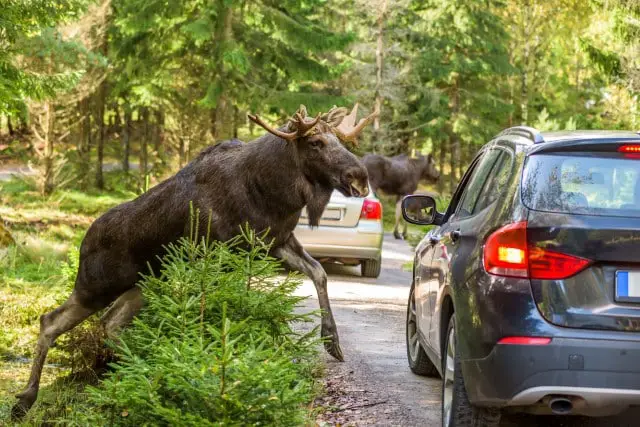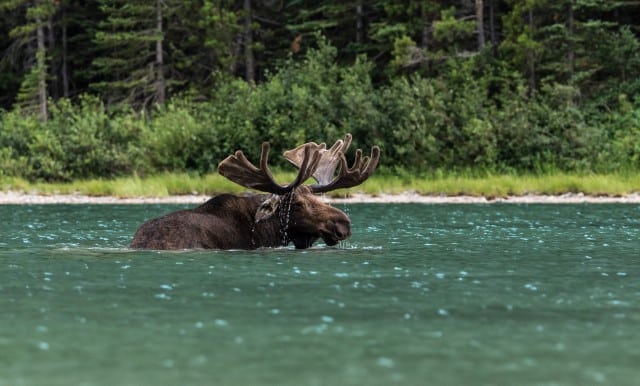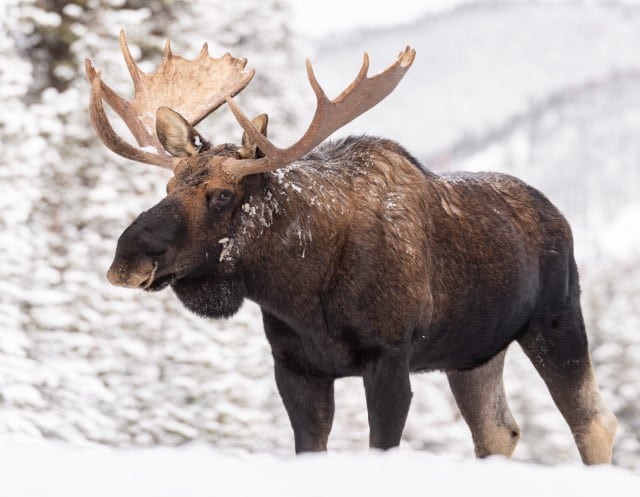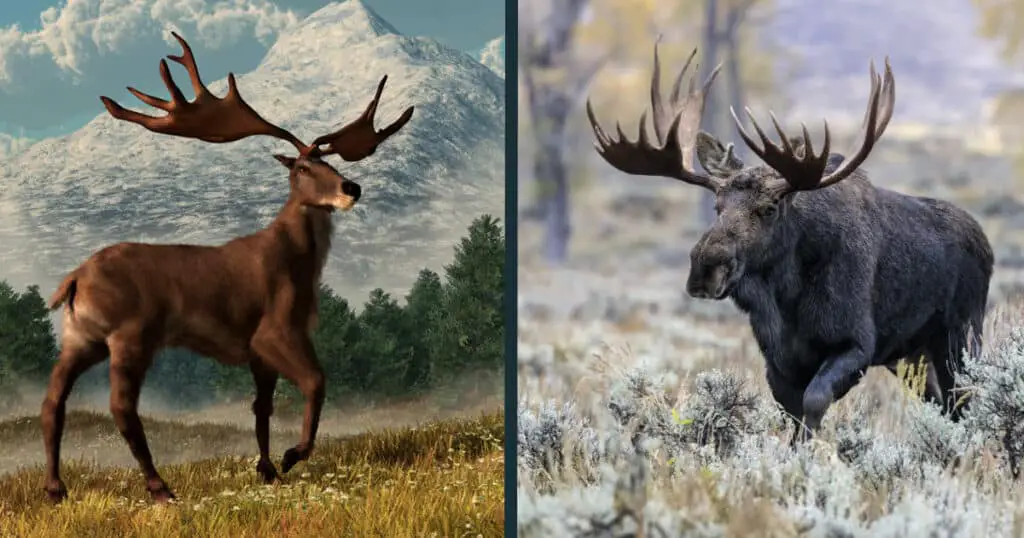Imagine you are on a nature trail and you come across a large deer-like animal with large antlers peacefully grazing. Chances are, you have come across a moose, but the largest deer species of all time (the now extinct Irish Elk) might be even more impressive. In today’s encyclopedia of animals, the deer family only runs so far. But there was a time where you likely would not have been able to make the distinction between a moose and its great relative – the Irish elk – quite so easily. Today we compare Irish Elk vs Moose to highlight the differences between the largest and mightiest of deer.
In this article we will be taking on the differences between the Irish Elk and the Moose. We will be highlighting key differences such as their sizes, diets, habitats and more.
By the end of this article, you will be a near expert in distinguishing the two – of course it helps considering one is extinct!
So, let’s get started.
Physical Characteristics
Table of Contents
ToggleIrish elk and Moose are two of the largest members of the deer family. The biggest difference and most notable between the two is that Irish elk were an ice-age relic and are now extinct.
Moose, on the other hand, are still around and are the largest deer species in the world. While they are very similar, they differ in their size, weight, habitats, and range.
Size to Scale
When we think about the differing physical characteristics between the two animals, the first thing that comes to mind would be how they have differed in size and features.
Irish Elk
The Irish Elk possessed several unique characteristics that set it apart from other prehistoric and contemporary mammals. The most distinctive feature of the Irish Elk was its enormous antlers.
They were among the largest antlers ever recorded in the animal kingdom, with some specimens having antlers that spanned up to 12 feet (3.6 meters) from tip to tip.
These massive antlers made the Irish Elk one of the most iconic and visually striking prehistoric mammals.
Moose
Moose are unique and fascinating creatures. Their sheer size is impressive and makes them an iconic symbol of the northern wilderness.

Moose have long, slender legs that are adapted for traversing through dense forests and deep snow.
Their long limbs make them agile and capable of moving efficiently in their wooded habitats. Moose are also excellent swimmers and are known for their ability to dive and feed on aquatic vegetation.
Both male and female moose have a flap of skin called a “dewlap” or “bell” hanging beneath their throat. This dewlap is covered in long, shaggy hair and is more prominent in males.
During the mating season, bulls use their dewlap to emit deep, resonant calls, known as “bellows,” to attract females and establish dominance.
Irish Elk vs Moose: Comparison Table
| Irish Elk | Moose |
|---|---|
| Antlers can range from up to 12 feet from tip to tip. | Antlers range from 5 feet to 11 feet from tip to tip. |
| Stands between 6 and 7 feet tall | Stands between 6 to 11 feet tall |
| Weighed up to 1,500 lbs or more | Weighs an average of 1,400 lbs |
| Range was from the western Atlantic ocean to modern day eastern Russia | Range includes North America, Europe, Asia |
| Preferred habitat was lake regions, open forests with spruce and pine | Preferred habitat is northern regions without deep snow, forests, and shrublands |
Habitat and Range Comparison
The Irish Elk and Moose exhibit distinct habitat preferences and geographical distributions. When we talk about habitat we are referring to the physical environment and conditions which includes the different factors in its surroundings such as vegetation, soil, and other animals in the area.
As opposed to range, which refers to the geographical area or region where the species is found on the map in a given time period. Here, we can see that Irish Elk and Moose differ in their range and habitat preferences.
Range – Geographical Distribution
The Irish Elk, despite its name, were found throughout Europe and parts of Asia during the Pleistocene epoch, from 400,000 to 10,000 years ago.
Moose are found in a more contemporary setting, inhabiting North America, Europe, and Asia.

In North America, they range from Alaska to the northeastern United States and as far south as the Rocky Mountains. In Eurasia, their distribution extends from Scandinavia to eastern Siberia.
Habitat Preferences – Irish Elk
Irish Elk preferred open grasslands, wooded areas, and the edges of forests. They were particularly well-adapted to temperate climates and lived in regions with a mix of open landscapes and dense vegetation.
Habitat Preferences – Moose
Moose are highly adaptable and can be found in a variety of habitats. They typically inhabit boreal and temperate forests, swamps, marshes, and riparian areas.
They are excellent swimmers and often seek out aquatic environments for foraging and refuge. Moose are known to frequent wetlands, marshes, and riparian zones, as these areas provide them with aquatic plants to feed on.
In some regions, moose can also be found in mountainous terrain, particularly in areas where forests extend into higher elevations. Their ability to forage on a variety of plants and adapt to different elevations contributes to their presence in mountainous habitats.
Behavior and Social Structure
Feeding Habits
Irish Elk are herbivores, primarily consuming grasses, herbs, shrubs and leaves from trees.
These large herbivores likely had a selective feeding behavior, using their teeth to browse on leaves and twigs from trees and shrubs. Their long antlers may have been used to reach vegetation.
Moose are also herbivores, but their feeding habits are more versatile than those of the Irish Elk. They are known to be both browsers and grazers.

They adapt their diet to the changing seasons. Their diet includes a wide range of plant species, such as tree leaves and twigs, aquatic plants, shrubs, and grasses.
They are excellent swimmers and often submerge themselves on underwater vegetation in ponds, lakes, and streams.
Mating Habits
The mating behaviors of Irish Elk and Moose differ. Irish Elk mating season is not well-documented, but it was probably influenced by environmental factors such as food availability and climate.
They were believed to engage in mating rituals that involved the use of their gigantic antlers. These antlers may have been used in visual displays and possibly combat with rival males to establish dominance and access to females.
Moose during mating season. They have a well-defined mating season known as the rut, which typically occurs in the fall, from late September to early November, depending on the location and climate.
During this time, both males (bulls) and females (cows) become more active and vocal in their search for mates.
Male moose engage in various displays to attract females and establish dominance. This includes vocalizations known as “bellows,” where bull moose emit loud calls to advertise their presence and intimidate rivals.
They also use their antlers for physical displays, such as thrashing vegetation and engaging in sparring matches with other males.
Competition: The rut is a highly competitive time for male moose, as they vie for access to receptive females. Dominant bulls with the largest antlers and successful displays have a better chance of mating with multiple females.
Mating Habits: Female Moose vs. Male Moose
Female moose are selective in their choice of mates. They may assess the strength and stamina of potential mates based on their displays and physical condition. Dominant bulls are more likely to secure mating opportunities.

Once a female has selected a mate, copulation occurs. After mating, the male’s involvement in raising the offspring is minimal, and females are responsible for giving birth to and caring for the calves.
Social Structure
The Irish Elk is believed to have had a relatively simple and limited social structure. Fossil evidence and reconstructions suggest that they were primarily solitary animals, with minimal evidence of complex social interactions or herding behavior.
Individual Irish Elk likely roamed their habitats alone or in small family units, possibly consisting of a mother and her offspring. They were not known for forming large herds or social groups, but during the mating season, males (bulls) likely engaged in competition and displays to attract females (cows).
These encounters were temporary and driven by the need to reproduce rather than the establishment of long-term social bonds.
Moose are generally solitary animals, and their social structure for most of the year is characterized by individuals leading independent lives. Adult males (bulls) are particularly solitary and often separate themselves from other moose.
During the rut (mating season), male moose may temporarily associate with females in estrus, but these associations are not stable, long-term social structures. Dominant males seek out receptive females and compete for mating opportunities.
Conservation Status and Threats
The conservation status of an animal refers to the risk of extinction faced by the species. As we have stated before, Irish Elk is an extinct species and moose are an extant species.
Conservation Status – Irish Elk
The Irish Elk is an extinct species, so there is no conservation status to evaluate. It disappeared around 10,000 years ago. Various factors, including climate change and overhunting by early humans, are believed to have contributed to its extinction.
The Irish Elk is one of the most well-known and spectacular megafauna species of the Pleistocene epoch. Fossil discoveries and reconstructions of Irish Elk have contributed significantly to our understanding of prehistoric ecosystems and the biodiversity of that era.
Despite its extinction over 10,000 years ago, the Irish Elk has left an enduring mark on cultural imagery.
Conservation Status – Moose
The conservation status of Moose varies depending on the region. In some areas, they are considered “Least Concern” by conservation organizations due to healthy populations.
This is common in places throughout the northern hemisphere with colder and more temperate climates.

In regions where Moose populations are healthy, they continue to be important for hunting and recreation. Moose hunting is regulated, providing both subsistence and recreational opportunities for hunters while generating revenue for conservation efforts.
Its meat provided sustenance, while its hides and bones were used for clothing, tools, and shelter.
Threats – Irish Elk
The Irish Elk faced threats back in their time such as changes in climate and habitat, which could have influenced the availability of food. Additionally, the expansion of human populations and their hunting activities have shown to have had an impact on its survival.
Threats – Moose
Habitat loss and fragmentation due to human development, agriculture, and infrastructure expansion can limit the availability of suitable habitats for Moose.

Climate change can affect Moose by altering the distribution and availability of their preferred food. It can also lead to increased stress from heat, parasites, and diseases.
Predation by wolves and bears can be a threat to Moose populations. And while legal hunting is a regulated activity in many regions, overhunting or illegal poaching can pose a threat, especially if not managed sustainably.
Our Final Thoughts On These Large Deer Species
In the end, understanding the difference between the Irish Elk and Moose species – or for any type of species for that matter, helps in bringing together the world in their appreciation for animals.
While the Irish Elk may be extinct today, seeing its traits in the modern day moose species is nothing short of the circle of life.
If you enjoyed this article, check out other comparison articles on our website, including our Moose vs Deer, Caribou vs Moose, and Moose vs Elk articles.



